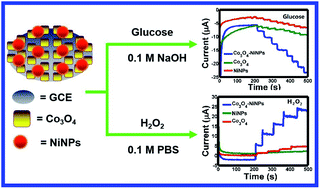The facile synthesis of a Co3O4–NiNP composite as an electrochemical non-enzymatic sensing platform for small chemical molecules
Abstract
In this paper, a new Co3O4–Ni nanocomposite-modified glassy carbon electrode (Co3O4–NiNPs/GCE) was successfully constructed and used to detect glucose and hydrogen peroxide (H2O2). The morphologies and structures of the Co3O4 and Co3O4–Ni nanocomposites were characterized via transmission electron microscopy (TEM), scanning electron microscopy (SEM), and X-ray diffraction (XRD). The construction process of the modified electrode was characterized via electrochemical impedance spectroscopy (EIS) and cyclic voltammetry (CV) techniques. Co3O4–NiNPs/GCE shows more excellent electrocatalytic activity for the detection of glucose and H2O2 compared with Co3O4/GCE and NiNPs/GCE. The amperometric i–t method was used for the quantitative analysis of glucose and H2O2. The plots of current difference versus concentration of glucose and H2O2 were linear in the range of 0.3–550 μM and 0.5–89 μM, respectively. The corresponding limits of detection (LODs) were 0.086 μM and 0.23 μM for glucose and H2O2, respectively. This recommended sensor was successfully applied for the quantitative analysis of glucose in fruit and H2O2 in water samples.



 Please wait while we load your content...
Please wait while we load your content...